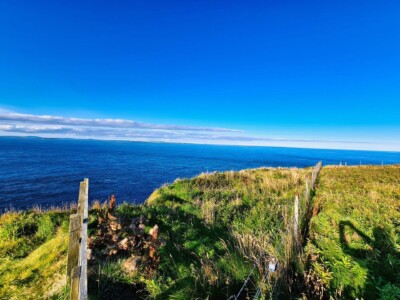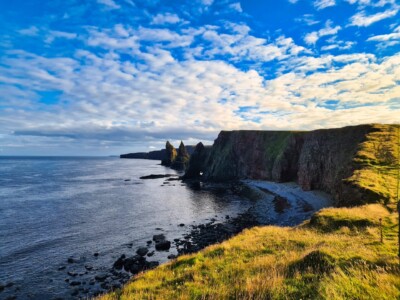Nestled in the furthest northeastern corner of the Scottish mainland is a site of natural wonder and beauty – Duncansby Head. This location, lesser-known to the general public compared to its neighbour John o’ Groats, offers breathtaking landscapes, intriguing landmarks, and peaceful walks that provide an intimate experience of Scotland’s rich coastal tapestry. For those yearning to unearth Scotland’s hidden treasures, Duncansby Head stands as a sentinel of time, with tales as old as the winds that sweep its shores.
Getting to Duncansby Head
Duncansby Head can be accessed by taking the A99 road. If you’re travelling from the south, drive northwards, past Wick, and follow signs leading to John o’ Groats. Before you reach John o’ Groats, a well-signposted side road will direct you to Duncansby Head. The journey is straightforward, with the route offering scenic vistas of the rugged Scottish landscape, and once there, ample parking spaces greet visitors.
Landmarks Worth a Visit
- Duncansby Stacks: Without a doubt, the most iconic sights here are the Duncansby Stacks – towering sea stacks that rise dramatically from the crashing waves below. Carved by centuries of erosion, they stand as grand monoliths, drawing photographers and nature lovers from around the world.
- Duncansby Head Lighthouse: This operational lighthouse stands sentinel on the clifftops, having been guiding ships since the 1920s. It offers panoramic views of the surrounding coastline and, on clear days, the Orkney Islands shimmer in the distance.
- Geo of Sclaites: A striking coastal ravine or ‘geo’, this feature is a testament to the power of the sea. The geo offers a safe haven for seabirds and provides visitors with a unique perspective on Scotland’s geology.
Walks Around Duncansby Head
Walking at Duncansby Head is an immersion into Scotland’s wild coastal beauty. Here are a couple of favourite routes:
- Lighthouse to the Stacks: Starting from the car park near the lighthouse, there’s a straightforward path that takes you to the magnificent views of the Duncansby Stacks. This walk, about 2 miles in total, lets you appreciate both the man-made wonder of the lighthouse and the natural majesty of the stacks.
- Coastal Path to John o’ Groats: A longer trek, this 4-mile route follows the coastline southwards, culminating at John o’ Groats. Along the way, you’ll traverse grassy moorland, spot myriad seabirds, and even witness seals lounging on the rocks below.
Remember, the weather in this part of Scotland can be unpredictable, so it’s advisable to don sturdy footwear and appropriate attire. And always let someone know where you’re headed if you’re going for a longer walk.
Interesting Facts About Duncansby Head
- Birdwatcher’s Paradise: Duncansby Head is teeming with birdlife. During spring and early summer, the cliffs become nesting grounds for species like guillemots, razorbills, and kittiwakes. With a keen eye, one might also spot puffins and the occasional peregrine falcon.
- Ancient Residents: Historically, the area around Duncansby Head was inhabited by the Picts, an ancient Scottish tribe. Various stone structures and carvings in the region stand testament to their presence.
- A Geological Marvel: Duncansby Head, with its sea stacks, arches, and geos, offers a fascinating insight into the geological processes that shaped the land over millions of years.
In conclusion, Duncansby Head is more than just a scenic spot on Scotland’s coast. It’s a confluence of history, geology, and biodiversity. Whether you’re a keen walker, a budding geologist, or someone looking for tranquillity, Duncansby Head is a destination that promises a rich and rewarding experience. So, the next time you’re charting a course through Scotland, make sure to set your compass towards this northeastern gem.














